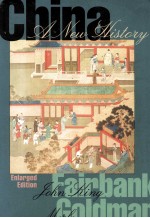图书介绍
CHINA A NEW HISTORY ENLARGED EDITIONPDF|Epub|txt|kindle电子书版本网盘下载

- 著
- 出版社: THE BELKNAP PRESS OF HARVARD UNIVERSITY PRESS
- ISBN:0674116739
- 出版时间:1992
- 标注页数:546页
- 文件大小:147MB
- 文件页数:565页
- 主题词:
PDF下载
下载说明
CHINA A NEW HISTORY ENLARGED EDITIONPDF格式电子书版下载
下载的文件为RAR压缩包。需要使用解压软件进行解压得到PDF格式图书。建议使用BT下载工具Free Download Manager进行下载,简称FDM(免费,没有广告,支持多平台)。本站资源全部打包为BT种子。所以需要使用专业的BT下载软件进行下载。如BitComet qBittorrent uTorrent等BT下载工具。迅雷目前由于本站不是热门资源。不推荐使用!后期资源热门了。安装了迅雷也可以迅雷进行下载!
(文件页数 要大于 标注页数,上中下等多册电子书除外)
注意:本站所有压缩包均有解压码: 点击下载压缩包解压工具
图书目录
Introduction: Approaches to Understanding China's History1
The Variety of Historical Perspectives1
Geography: The Contrast of North and South4
Humankind in Nature14
The Village: Family and Lineage17
Inner Asia and China: The Steppe and the Sown23
PART ONE Rise and Decline of the Imperial Autocracy27
1. Origins: The Discoveries of Archaeology29
Paleolithic China29
Neolithic China31
Excavation of Shang and Xia33
The Rise of Central Authority37
Western Zhou39
Implications of the New Archaeological Record40
2. The First Unification: Imperial Confucianism46
The Utility of Dynasties46
Princes and Philosophers49
The Confucian Code51
Daoism53
Unification by Qin54
Consolidation and Expansion under the Han57
Imperial Confucianism62
Correlative Cosmology64
Emperor and Scholars66
3. Reunification in the Buddhist Age72
Disunion72
The Buddhist Teaching73
Sui-Tang Reunification76
Buddhism and the State79
Decline of the Tang Dynasty81
Social Change: The Tang-Song Transition83
4. China's Greatest Age: Northern and Southern Song88
Efflorescence of Material Growth88
Education and the Examination System93
The Creation of Neo-Confucianism96
Formation of Gentry Society101
5. The Paradox of Song China and Inner Asia108
The Symbiosis of Wen and Wu108
The Rise of Non-Chinese Rule over China112
China in the Mongol Empire119
Interpreting the Song Era126
6. Government in the Ming Dynasty128
Legacies of the Hongwu Emperor128
Fiscal Problems132
China Turns Inward137
Factional Politics140
7. The Qing Success Story143
The Manchu Conquest143
Institutional Adaptation146
The Jesuit Interlude151
Growth of Qing Control in Inner Asia152
The Attempted Integration of Polity and Culture154
PART TWO Late Imperial China, 1600-1911163
8. The Paradox of Growth without Development167
The Rise in Population167
Diminishing Returns of Farm Labor170
The Subjection of Women173
Domestic Trade and Commercial Organization176
Merchant-Official Symbiosis179
Limitations of the Law183
9. Frontier Unrest and the Opening of China187
The Weakness of State Leadership187
The White Lotus Rebellion, 1796-1804189
Maritime China: Origins of the Overseas Chinese191
European Trading Companies and the Canton Trade195
Rebellion on the Turkestan Frontier, 1826-1835197
Opium and the Struggle for a New Order at Guangzhou, 1834-1842198
Inauguration of the Treaty Century after 1842201
10. Rebellion and Restoration206
The Great Taiping Rebellion, 1851-1864206
Civil War209
The Qing Restoration of the 1860s212
Suppression of Other Rebellions214
11. Early Modernization and the Decline of Qing Power217
Self-Strengthening and Its Failure217
The Christian-Confucian Struggle221
The Reform Movement224
The Boxer Rising, 1898-1901230
Demoralization232
12. The Republican Revolution, 1901-1916235
A New Domestic Balance of Power235
Suppressing Rebellion by Militarization236
Elite Activism in the Public Sphere238
The Japanese Influence240
The Qing Reform Effort241
Constitutionalism and Self-Government244
Insoluble Systemic Problems247
The Revolution of 1911 and Yuan Shikai's Dictatorship250
PART THREE The Republic of China, 1912-1949255
13. The Quest for a Chinese Civil Society257
The Limits of Chinese Liberalism257
The Limits of Christian Reformism260
The Tardy Rise of a Political Press262
Academic Development263
The New Culture Movement266
The May Fourth Movement267
Rise of the Chinese Bourgeoisie269
Origins of the Chinese Communist Party275
14. The Nationalist Revolution and the Nanjing Government279
Sun Yatsen and the United Front279
The Accession to Power of Jiang Jieshi (Chiang Kaishek)283
The Nature of the Nanjing Government286
Systemic Weaknesses289
15. The Second Coming of the Chinese Communist Party294
Problems of Life on the Land294
Rural Reconstruction299
The Rise of Mao Zedong301
The Long March, 1934-1935305
The Role of Zhou Enlai307
The Second United Front310
16. China's War of Resistance, 1937-1945312
Nationalist Difficulties312
Mao's Sinification of Marxism316
Mao Zedong Thought321
The Rectification Campaign of 1942-1944323
American Support of Coalition Government326
17. The Civil War and the Nationalists on Taiwan331
Why the Nationalists Failed331
Nationalist Attack and Communist Counterattack334
Taiwan as a Japanese Colony337
Taiwan as the Republic of China339
PART FOUR The People's Republic of China343
18. Establishing Control of State and Countryside345
Creating the New State, 1949-1953345
Collectivizing Agriculture352
Collective Agriculture in Practice354
Beginning Industrialization357
Education and the Intellectuals359
The Anti-Rightist Campaign, 1957-1958365
19. The Great Leap Forward, 1958-1960368
Background Factors368
The Disaster of 1959-1960372
Revival: Seizing Control of Industrial Labor374
Party Rectification and Education376
The Sino-Soviet Split378
The Great Leap Forward as a Social Movement380
20. The Cultural Revolution, 1966-1976383
Underpinnings383
Mao's Aims and Resources385
Role of the People's Liberation Army387
How the Cultural Revolution Unfolded389
The Red Guards391
The Seizure of Power393
Foreign Affairs395
Decentralization and the Third Front397
The Succession Struggle400
The Cultural Revolution in Retrospect401
Aftermath404
21. The Post-Mao Reform Era&by Merle Goldman406
Epilogue: China at the Close of the Century&by Merle Goldman451
Note on Romanization and Citation458
Suggested Reading459
Publisher's Note515
Illustration Credits517
Author Index521
General Index531